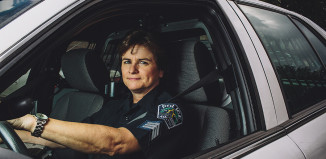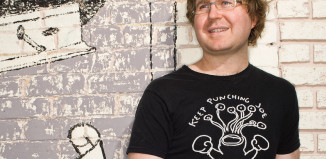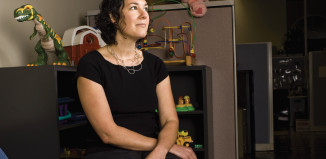Lying under a blanket on a comfy recliner at Acupuncture Together, Ashley O’Brian’s community acupuncture clinic, waiting for her to place the needles into my body, many thoughts are going through my head as I listen to the soothing music being piped into the room: Are the nee- dles going to hurt? Will this really relax me? Should I be meditating as well? Will it help with my allergies and back pain? What exactly is community acupuncture, and what will it cost me financially? As a newbie to acupuncture, my concerns were typical.
With O’Brian’s deep blue-grey eyes and warm, professional demeanor, it’s easy to understand how she puts her patients at ease. She calmly debunked several myths right away: Not only will the needles—barely thicker than a strand of hair—not hurt, you’ll barely feel them at all. The treatment will relax you and, with regular visits, can reverse or help treat a wide range of common ailments. You are not required to meditate, but you’re welcome to listen to whatever relaxes you on your headphones. Community acupuncture is a grassroots movement to make the practice accessible and affordable to the wide range of people who cannot afford the typical $60 to $100 per treatment that private room practitioners tend to charge. Their solution: Treat several people, all at once in a big room, and charge them $15 to $40 per treatment on a sliding scale.
“I’ve always wanted to be a helpful person. It makes me feel good to help people, ease their suffering, and do whatever needs to be done,” said O’Brian, who worked as a massage therapist for a decade prior to opening her clinic in February 2010. “I want to use this article to spread the word about community acupuncture. I feel like there are so many people who still don’t know about it.”
Acupuncture is an alternative medical therapy that treats patients by the insertion of needles at specific points in the body, and it can be used for a wide range of ailments: muscle and joint pain, allergies, migraines, infertility, as well as stress, depression, digestive problems, high blood pressure and more. It is believed that the earliest written mention of the practice dates back to an ancient Chinese medical text from 2,000 years ago.
 Patients typically become very relaxed and either doze off or fall asleep completely during treatments. Just the simple act of sitting still for at least 30 minutes is itself extremely healing and helps people to let go of stress, O’Brian said. With her partner of 14 years, Dianne Shelton, and their 7-year-old son, she loves being able to set her own hours and still make time for her family.
Patients typically become very relaxed and either doze off or fall asleep completely during treatments. Just the simple act of sitting still for at least 30 minutes is itself extremely healing and helps people to let go of stress, O’Brian said. With her partner of 14 years, Dianne Shelton, and their 7-year-old son, she loves being able to set her own hours and still make time for her family.
Even so, starting any type of small business is daunt- ing. At the beginning, O’Brian knew very little about renting commercial space or the city’s many regulations. Six months after resolving to open, however, she was in business. By the time of the interview in October, her clinic’s eight chairs had hosted more than 2,000 treatments in 2011 (she has one employee), with a goal of 7,500 treatments per year.
O’Brian stated that part of the reason some acupunc- turists may charge a lot is because of the cost of acupunc- ture education, which is around $50,000 and provides most people with a master’s degree in Oriental Medicine. She received her degree in 2003 from the AOMA Graduate School of Integrative Medicine in Austin. The four-year, full-time certification is similar to “a trade school combined with a master’s program,” she said, adding that her undergraduate degree from UT was in studio art. Acupuncture students are required to give hundreds of treatments during the internship portion.
Her sister-in-law, Wendy, is one of many satisfied patients. A friend for 14 years, she’s been to Acupuncture Together for aches and pains associated with injuries and allergies. “Ashley’s commitment to a ‘pay what you can’ business approach makes her unique among her peers,” said Wendy. “Because she believes that all people should have access
to acupuncture regardless of income, an immediate connec- tion with her clients is formed. Plus, she has a very gentle and professional demeanor, which is comforting to people new to acupuncture.”
Growing up in a very conservative small Texas rice-farming town and then moving to Austin to attend UT, O’Brian experienced a bit of culture shock: Suddenly, people were expressing themselves and dressing differently. Even though her stepfather was a Presbyterian minister, she was never forced to attend church as a teenager. In fact, it was her biological father and her mother who had a harder time with her sexuality at first.
“My mom was the most important woman in my life up until a certain point, and then she wasn’t,” said O’Brian. “I think that’s a little hard for mothers. It was a gradual acceptance over the years. All three of my parents love Dianne—she’s absorbed into the family now.”
Back in 1997, Shelton was reading Tarot cards at a Club Skirt dance at the Zilker Clubhouse (a popular social night for lesbians in the 1990s). O’Brian had just ended a prior relationship and had decided to go out. Thirty minutes after reading O’Brian’s cards, Shelton went up to O’Brian and gave her a piece of paper with her phone number on it and said, “If you ever want your cards read again, call me.”
It turns out that Shelton had never asked anyone out that way before, although she told O’Brian later that she sensed she would meet someone new that night. A few months later, they met again at a similar event and sat down to talk.
Shelton, a resident of Austin for two decades and a fifth-generation Texan, describes herself as “bi-vocational.” She works in human resources for a large engineering and technology firm, and she’s a spiritual teacher/healer. Date nights, when there’s a babysitter, usually involve dinner and a movie.
Their connection as a couple stems from what Shelton characterizes as a shared belief in each other’s “divine potential” and the depth of love they share for their son. “Our boy has taught us more about ourselves and about love than anything else.”
Jacob, 7, attends elementary school in Brentwood and fits right in. He sees his father, a friend of the family who lives in Austin, on a regular basis. For O’Brian, what has been the most surprising aspect of being a mom?
“How much I find myself acting like my mother,” she said, smiling, before adding, “and the fact that my child— I had an idea in my mind of what he might be like—is completely different. The way he looks, the way he acts. He’s completely his own person.”
Discrimination is not something she’s dealt with at work. “If someone asks me, ‘does your son look like your hus- band?’ I say, ‘I have a wife’ or ‘I have a female partner.’ I don’t know of anyone who would be angry about it.”
When O’Brian first opened her business, there was a lot of work to build the foundation and get everything going, but now she takes appointments from 8 a.m. until 1 p.m. (she can see up to six people per hour) so that she has plenty of time for her family. Another acupuncturist works at the clinic in the afternoons and evenings.
As the business settles into a regular rhythm, O’Brian wants to make more time for nonprofit volunteer work.
One place where she can see herself volunteering in the future is Acupuncture Without Borders, an organization that was formed in the aftermath of Hurricanes Rita and Katrina and works to bring the practice to underserved populations such as lower-income folks and U.S. military veterans.
She is proud that her patients pay much lower rates for her services with their own money (and therefore not relying on the American health care system). “Health care is a basic need for humans, and it is sad and wrong that the insurance and drug companies make it inaccessible for most Americans,” she said.
This desire to give back runs in the family. O’Brian’s stepfather spent a lot of time with sick and elderly people as part of his job as a minister. Prior to figuring out that she wanted to open her clinic, O’Brian was looking for some- thing meaningful. They’d lost a good friend to pancreatic cancer, and she had had hospice care, and O’Brian saw what a big difference it made in her life. She decided to become a volunteer for Hospice Austin. “I was on a journey of my own just to accept death—for myself,” she said. “We’re all mortal. I was trying to have some growth in that area.”
Hospice Austin puts volunteers through intensive training (at least 30 hours). It included face time with people in related fields, like ministers, nurses, social workers, and funeral directors. O’Brian said that the most important lesson was how to be present with someone who you knew would not be around for very long—and how to be okay with that.
Her first placement through Hospice Austin was with a 99-year-old woman, living in her own house by herself. “She just wanted me to play dominoes with her and cook sauerkraut and pork chops. She told me stories about her childhood in the early 1900s out in the Hill Country in a family of German immigrants.”
One woman O’Brian admires and looks to as a mentor is Lisa Rohleder, a cofounder of Working Class Acupuncture in Portland, Oregon and one of community acupuncture’s leading proponents nationally. She became aware of Rohleder’s work several years ago, has seen her in the documentary Community Acupuncture: The Calmest Revolution Ever Staged, and has also read several of her books. Recently, O’Brian had the pleasure of meeting Rohleder in person when she and her husband came to Austin to give a workshop for acupuncturists about community acupuncture.
“She doesn’t let anything stop her, she stands for what she believes in, and she seems to stay one hundred percent true to herself,” said O’Brian.
It may seem simplistic, but O’Brian wants to change the world, much like Rohleder has, one person at a time, with acupuncture. “The whole point is to provide affordable medicine without using government help or insurance,” she said. “I’m committed to offering that to the people of Austin.”
Her partner summed up their ethos succinctly: “We aren’t trendy or hip. We aren’t A-listers in the gay and lesbian community. We make a difference by living each day fully engaged in our love for each other, our love for our family, and our love for our respective communities. It may sound quaint, but it is true.”




































